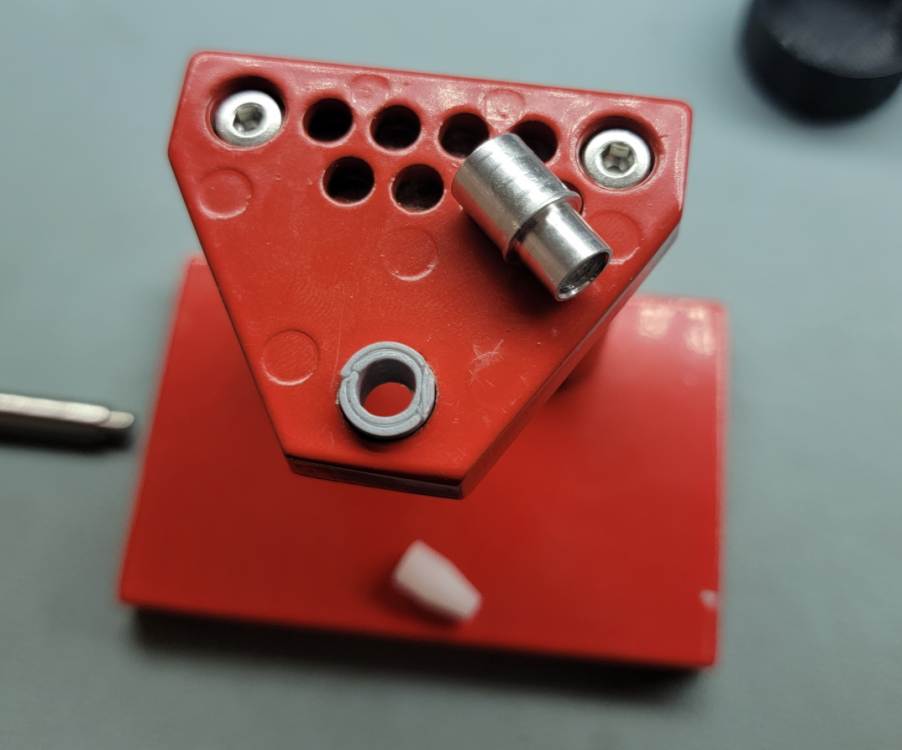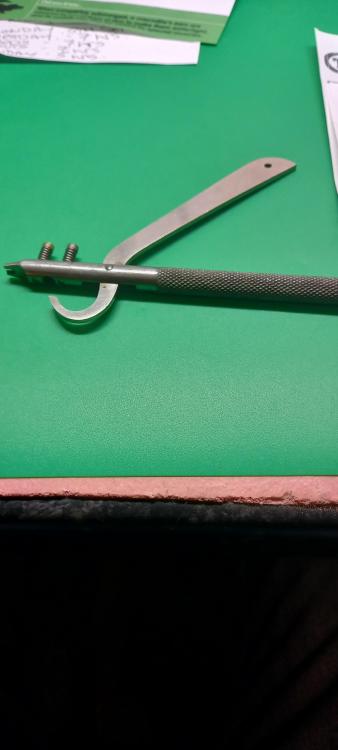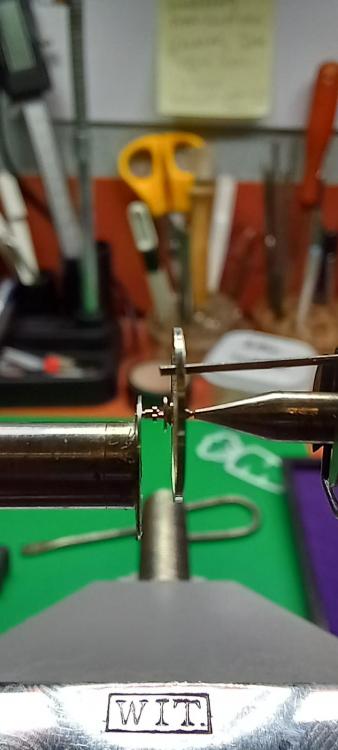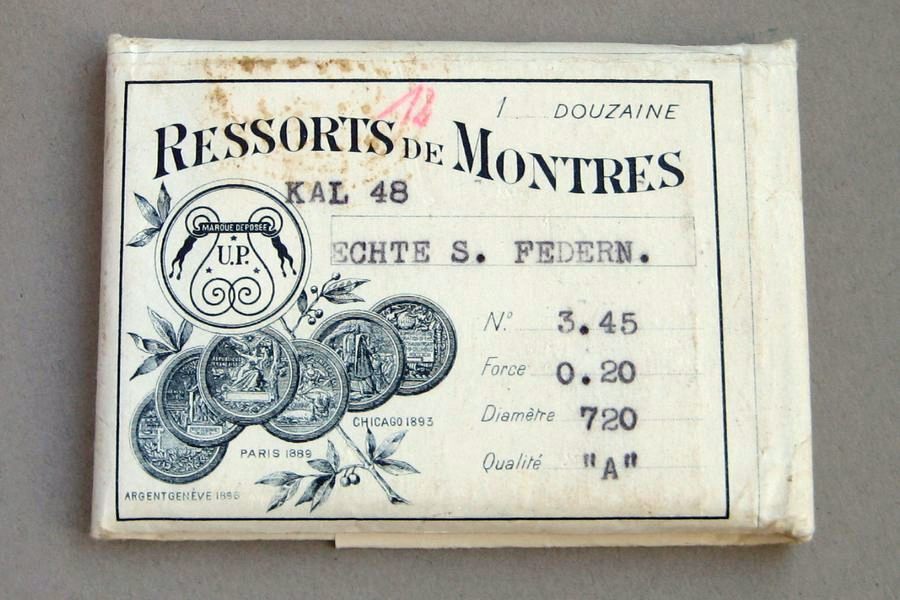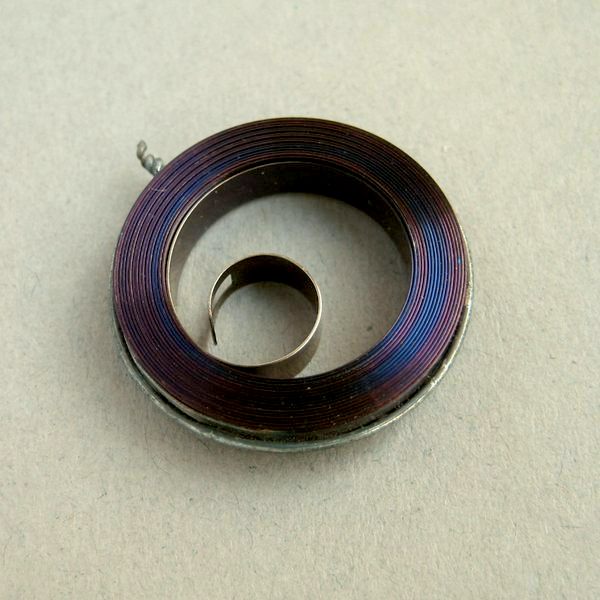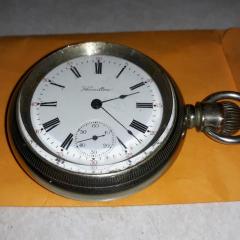Leaderboard
Popular Content
Showing content with the highest reputation on 09/28/22 in Posts
-
That looks like the hairspring stud holder: if you move it, it will change the beat error. The other arm with what appears to be two brass pins is the time regulator: if you move it, it will adjust the effect length of the hairspring.3 points
-
One thing that I am happy about is that I went with the twin boom stand, many degrees of freedom and very stable. The base is heavy, and will give you a good workout when you move it.2 points
-
Steel mainsprings won't have an S curve, and also some new springs are a simpler stainless alloy that doesn't necessarily have an S curve. Generale Ressorts springs in the red retaining ring are the simpler alloy, the blue rings are Nivaflex- Nivaflex will always have the S curve. For steel springs there's a rule of thumb that if it opens up more than twice the barrel diameter, or about the size of the movement, it's not set. I don't know if the above spring is steel or alloy, but it looks good to me!2 points
-
2 points
-
I have one of these cheap Chinese hand setters that I bought last year. Quit using it almost the day it arrived because the bushing is a sloppy fit to the press. I bought a set of hand hand-setter and have been using them ever since. So, fast forward...working on an Elgin 539 with a sweep-second wheel that is press fit on the third-wheel pivot, I realized how important it is to get direct vertical pressure on the wheel when installing. I decided to revisit the Chinese press. Here you can see that I have replaced the metal bushing with a plastic (really PLA) one that I 3d printed. It is very solid now. Maybe I will start using it again.2 points
-
Sounds like they didn't open up the watch to assess it, just put it on a timegrapher. If they are going to say the warranty is void because of misuse/damage, showing case damage isn't sufficient. I would want them to be specific about how the movement was damaged. I'm never happy, but I try not to take it out on people who are trying to do good work Cheers!2 points
-
2 points
-
Eyup muckers hope you all well. So into my first endeavour of using the Jacot. Last week i had two new tool arrivals in the the post. A DL PP make and a WIT Jacot. The WIT is in the better condition so i tnought i would start there. Been fiddling around with an old well knackered Osco movement back and forth for a ages, basically just abusing it for practising things i haven’t tried before inbetween some repair. Trashing bits and pieces and seeing if i could bring them back to life as you do. Its basically become my whipping boy movement. So he's down for another session, balance assembly out, collet off and ready to fit the staff and wheel into the Jacot after a measure of the staff pivot which came out at 0.7mm. Relatively small for my first attempt. Aannndd man what a bartender to set up, talk about bloody hard to fit the staff. I'm doing this with a x10 loupe attached to some +3 reading glasses, so magnification is not the best but its ok i can see reasonably well what im doing. Now i thought i had steady hands i can manipulate hs to a good standard if i had to blow my own trombone. But this is another level, using a loop and with my hands in the air, in the gym this free hand completely unassisted exercise is what Bros call doing it RAW. Yep this is pretty raw, I've nearly trashed the pivot 3 times already, but its holding out to my abuse. Any tips anyone ? As cool as i am , I'm starting to feel a little stressed. Its in. Over half an hour and 2 cuppas later. Man tell you what, all respect to anyone that can get a small balance staff set up in a jacot tool straight off the bat. Tbh i will be surprised if i havent trashed at least one of the pivots., though the balance wheel is spinning very well with a blower. I may be lucky.1 point
-
Actually, it says "Do not open - Bulova-sealed lifetime power" stamped into the barrel lid. The barrel is from a 1967 11 ALAC movement. It seems tired, 55 years old. Do I open it, clean/lube, wind it on a winder and try it? Or do I measure the mainspring and get a new one? Please advise. Thanks, - Tim1 point
-
Are you asking how to measure the inside diameter of the roller table? If so, I have used a brass tapered pin and marked it with a black marker. Then I drop the roller table down on the pin until it is snug. Then I spin it a bit to make a mark. After removing it, I have a mark to measure to. There is probably a better way professionals do this. I wish I had something similar to my jewel hole diameter tool to do this.1 point
-
You will still get use from it, as a beginner any movement you will learn from. Enjoy1 point
-
1 point
-
I decided to invest in the Horotec original hand setter and it has been working perfectly. Worth the money IMO. I came to the same conclusion and that's why I decided to pull the trigger. It is very difficult to be absolutely vertical using manual hand fitting tools. Doing it with the Horotec makes the process quite painless.1 point
-
I just thought of a method of making a pivot burnisher which might be easier than the method described by de Carle. I already have all the necessary tools. It's the same method for making the square section of a winding stem. The rectangular/square rod can be clamped into a 4 jaw chuck on the lathe and the filing rest adjusted to just graze and roughen/smoothen the carbide rod. The filing rest would keep the surface of the metal flat. A very rough diamond file should be able to gjve the correct grain texture of the rough end. For the smooth end, probably a #1000 or higher diamond file would give a nice surface.1 point
-
The micrometer discussed in this thread is one of the most useful for watchmaking, especially measuring things like staffs.1 point
-
That thought also entered my mind, wrap the parts in tissue ? . I jest . Lol i have to cut down, i have upset someone.1 point
-
1 point
-
As ifibrin has said this is the beat adjuster of the movement. When they are shorter than the timing adjuster ie. The stud inside the diameter of the regulator pins then that would be an overcoil hs also know as Brequet developed by Abraham Brequet. Its a more accurate hs than the flat, less restricted in its movements. This is not the case here. Some studs are also fixed making beat adjustment much more difficult over an adjustable one. This fixed variation is common on older vintage watches. You have both timing and beat adjustable arms here.1 point
-
Paul come on mate i apologise, i was just acting like a tool . You know i do this sometimes. I used a poor choice of words. This is a cracking thread you started, ive used its recommendations to buy in the past. 🏳🏳🏳🏳🏳🏳🏳🏳🏳🏳. Its really bugging me to think ive upset you 🏳🏳🏳🏳🏳🏳🏳🏳🏳1 point
-
That sounds like the ideal working situation. Cheers matey. Unless something else spectacular pops up on ebay at an impossible to turn down price, I'm happy now to along with one like Alex and you use.1 point
-
@Paul80IMO this is one one of the most interesting threads for hobbyist watchmakers, and quite unique among watchmaking forums. Please keep it alive.1 point
-
i'm still dealing with this same rubbed in jewel issue on a Hamilton, and am searching for jewel setting tools. were you able to replace it? I had to get a donor movement and am going to attempt to replace it with that jewel.1 point
-
Actually, @Mark has mentioned before that some chronograph seconds hands are fitted extra tight into the pivot, which makes sense due to the extremely large rotational forces that the central chronograph seconds hand faces when reset. These hands can be almost impossible to remove without damaging the tube, and some manufacturers consider these hands one use only. Which is why I was wondering if the tool I mentioned would be able to circumvent this… @Paul80 your posts in this thread are much appreciated, and I think there has been some misunderstanding here between you, and @Neverenoughwatches’s peculiar sense of humour. Please don’t go.1 point
-
The more I look at the issues you guys are having, the more I feel I should just cobble up something myself. I’m thinking of getting the Elma basket complete (around 130GBP) and rigging up a stepper motor to drive it (which would give me the bidirectional rotation) and controlled speed for when the basket is lifted out of the solution to spin off excess fluid. The only expensive part here would be the Elma basket complete - maybe I should just pull the trigger and get it. That’ll put my backside into gear and do this1 point
-
Yeah so mine came with 10x eye pieces as standard, but I did have to add the 0.5x Barlow lens at the bottom to give me the 200mm working distance (a critical item missing from the package I linked earlier). This whole combination gives me 3.5-22.5x in total (thanks @HectorLooifor making me check to make sure) and fully zoomed out I have around 50’ish mm FoV at 200m working distance. I posted pics in this thread a few months ago where I measured it.1 point
-
Try Dave’s watch parts he has old Waltham jewels,good luck1 point
-
Well, here's an update so far. On the left is the original rotor. The black one on the bottom is a 3D printed model of a redesigned rotor (https://www.thingiverse.com/thing:5535977). And above that is an aluminum rotor I made with a 3D printed cap I was going to attach to it to force the water down into the basket. The third one isn't done yet...was waiting for some hardware to come in. But I did learn something from the 3D printed model...Something about my stock shaft is messed up. I think a majority of the shaft is true, but the portion at the end where the reduced the shaft to 8mm must be cut wrong because I experience the same wobble as the original rotor. And this is confirmed by the dial indicator on the cut portion of the shaft. (**Edit: i need to explore this more, with more examination my 3D printed rotor is actually warped a bit. ABS does have a tendency to pull up and warp from the print bed.) Second thing I learned, there is something definitely off about the baskets as well. With that wobble from the shaft, both baskets run better in one of the 3 directions, and one of the baskets runs significantly better than the other. So honestly, not really sure where to go from here unless I want to get a new shaft to solve problem #1. For now, I guess I'll just run it with the stock stuff, in the best basket position. It still works better than when I started, but it would've been nice if I could've gotten it perfect. Who knows, I'll probably order a new shaft a few moments after I post this...1 point
-
My pin vise jaws are made of brass, so it won't hurt the pinion leaves. BTW, you didn't need to use the #11 blades to raise the height. The plastic tip of the cannon pinion puller can be screwed out adjust the position of the jaws.1 point
-
@Paul80, I've very much appreciate your posts. Reviews of tools are very valuable, especially when one is taking a chance by buying from some place like AliExpress.1 point
-
We all do. I make plenty, but I try to correct them, and I appreciate it when I'm educated by others. These videos live forever, very few are ever fixed. If someone is watching these for "entertainment", no harm done. If, however, they are like me, and trying to educate themselves, then watching a video that is supposedly for educational purposes and the information that is presented is wrong, then I get really annoyed. I spent a very long time trying to wade through all of the scattered and unhelpful info on these inspection scopes before I finally purchased one. I was out of the electronics and electronics repair field before they were routinely used and available, so I had no experience with these types of microscopes. Trying to figure out how the lenses all worked together to get a certain level of magnification, field of view, and working distance was not easy. I think I got it right, but it took me *years* before I was ready to pull the trigger. I didn't have, and certainly don't have now, the kind of money where I can afford to make a mistake on an expensive piece of equipment like a good scope. Muddying the waters is not helpful1 point
-
According to Nicklesilver that is exactly what it is called. The jaws are actually recessed so a lot thinner than they look. So my curiosity sparked up and i had a measure. A fraction under 0.7mm. I am guessing but i think Nicklesilver is the only other person that has one here. Never heard them mentioned until i was wanting to know what it was. At least you got it sorted with some good initiative and a sprinkling of bravery . What all good watch repairers endeavour to acquire1 point
-
1 point
-
remember without the customers the company doesn't exist so you always blame the customers because it's their fault the company exists at all and is having to suffer to deal with the customer. I would be really concerned about a watch like this it already needs to be serviced in less than three years. The case is basically worn out in less than two years. is it interesting conflict between the sales department who probably is trying to convince you that this is a wonderful watch and the servicing department indicating your watch is worn out needs to be basically be replaced.1 point
-
Here we have an interesting discussion regarding the use of a particular tool and a problem encountered when removing a set of hands. The same has happened to me but not on an expensive watch so did not cost an arm and a leg. I understand Paul80's concern and passing on the information so as to help others doing the same thing or be aware of the fact it can happen and its possible prevention by using a particular tool. Dissemination of information is essential in any forum, cheers for that Paul80.1 point
-
Absolutely not Paul, you know very well that i value your info. I was just having a silly hour, you should know me by now. If it makes you feel any better i will bend over and you can stick my white flag where the sun don't shine. Now come on mate thats funny.1 point
-
It has absolutely nothing to do with Sinn. It's an ETA 2824-2. The same is true for other ETA movements, for example, the 2892-A2. Anyway, the slot is actually a good design which will prevent you from pushing the setting lever button too far. That is, you use a suitable screwdriver to push the button. However, it's not super-sensitive. You can push using for example a pointed piece of peg wood, but then you have to pull on the crown continually and stop pushing as soon as you feel the stem is coming out. Sometimes, but not often, this is even necessary when the slot (for some unknown reason) is slightly too shallow.1 point
-
Perfect advice from Karl. Within a month of starting i realised as Karl has said that i needed some stock behind me to backup any losses or breakages i would eventually encounter. And yes tweezers and screwdrivers you should choose of good quality and learn to dress and shape them accurately. It does make a huge difference to driver slippage and tweezer pingage.1 point
-
And even if you determine exactly the right staff for your watch, there's a risk that even a good supplier might still send the wrong one. Or the guy before you got the wrong one and reamed out the roller table to fit, etc.1 point
-
I think the rivet holding the hand to the tube was loose. The hand would have come off regardless of the tool used. This hand remover pushes the pivot out of the tube, reducing the risk of the pivot breaking off or bending. If the hole in the chrono hand is not enlarged, it might be possible to refit the hand and expand back the rivet to hold it. Watch this video on how a hand tube is made. I just thought of something... not all hand tubes have a hole on top. If you use a pusher like this on a tube with no hole or use a pin that is bigger than the hole, you'll end up pushing the tube out of the hand.1 point
-
another reference for cross-referencing parts is at the link below which does bring up another problem. as you see there were lots of variations of the third wheel seat at the very careful in ordering one to order the exact one that you need or you'll be in for a surprise. then the other thing nice about the site below is when you click on the wheel you think you want to purchase whether or not they still have it or not you get the second link which lists all the watches that use the same part in other words you get the cross reference then the part number is looking for would be 214/30. This is where unfortunately the online material houses will typically not list this kind of thing. Is where you have to make an inquiry to the various material houses as to whether they have the part. Because they have way more parts not listed than they actually have listed then sometimes you can take the part number and go to their home page of the main websites and at least it find out whether it's still available but it doesn't even come up on the listing. In fact he gets confused with it being out lot of other things which is very unhelpful. http://cgi.julesborel.com/cgi-bin/matcgi2?ref=BUL_10AK http://cgi.julesborel.com/cgi-bin/matcgi2?ref=V]^DZD1 point
-
did the entire setting come out cleanly? Then as nice as the pocket watch database is sometimes it's nice to have your own catalogs. Here's a older version of a parts catalog https://archive.org/details/catalogueofwalth00walt/mode/2up1 point
-
I'm still waiting for this to become affordable.1 point
-
Who said anything about trying to vindicate myself, a question was asked I tried to answer that was all FFS man what is wrong with you tonight. Look I broke something taking it apart it cost me a small fortune to put it right and I was trying to explain what I did wrong to help others, this appears to be wrong. Shan't bother again. Goodbye. Mark can you lock this thread as I will not be adding any more of my Chinese tools . Thanks0 points






